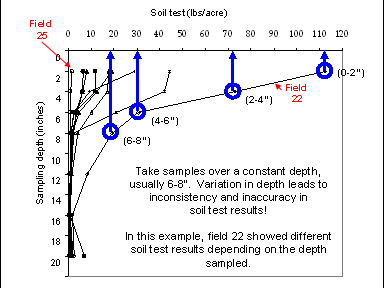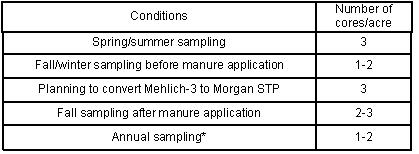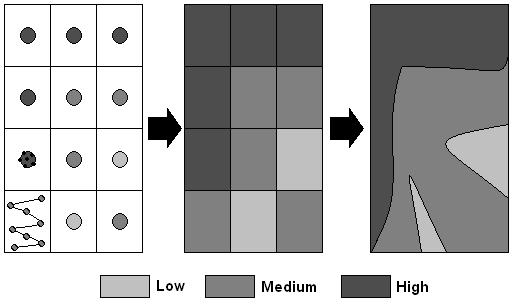PO 20. Describe soil sampling strategies.
- Random sampling
- Grid-based sampling
- Soil-type based sampling
|
To obtain an accurate soil test:
- Use the right sampling tool: a probe or auger and a clean plastic bucket.
- Take 2-3 subsamples/acre across uniform fields.
- Avoid sampling when the soil is very wet.
- Scrape away surface litter.
- Take equal amounts for each subsample.
- Take cores to plow depth (no-till: 0-1 and 0-6 or 8")
- Sample between rows, avoid fence rows.
- Remove stones, wood, trash.
- One sample should represent one management unit.
- Mix subsamples and take a 1 cup subsample.
- Label sample and note down label and location.
To generate the best soil record database:
- Always take samples in the same time of the year, and test at appropriate intervals, either annually or every other year. Regulations require testing at least once every 3 years.
- Stick to the same lab, as results from different labs cannot be combined to create a historical record.
To take an accurate soil sample:
- Depth: 6-8 inches for general soil tests. Exceptions include the PSNT (12 inches deep) and no-till pH testing (1 inch and 6 inches).
- Generally, one sample should not represent more than 10 acres (unless past sampling shows minimal differences). Variability is caused by soil forming processes, fertilizer applications, manure spreading, and tillage systems.
- One sample should represent one management unit, considering soil type and past management
|

For proper soil sampling, the soil probe should be inserted into the soil perpendicular to the ground, and to the appropriate depth.
(image source)
|

|
Guidelines for Sampling

|
Mehlich-3 to Morgan conversion may provide unsatisfactory results across years. When using a conversion, one sample per acre annually is only a substitute if the accuracy of the conversion equation has been checked (i.e. sample is split, sent in for both Morgan and Mehlich-3 analysis, and both the true Morgan and the estimated Morgan compare well).
|

Strategic soil sampling across a field allows the user to generate a map of the field based on soil types and characteristics. When possible, these characteristics should be incorporated into the management of the area. (Image adapted from the NRCCA training manual, PO 20.)
return to top | previous page | next page




